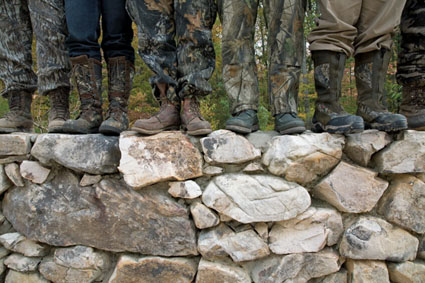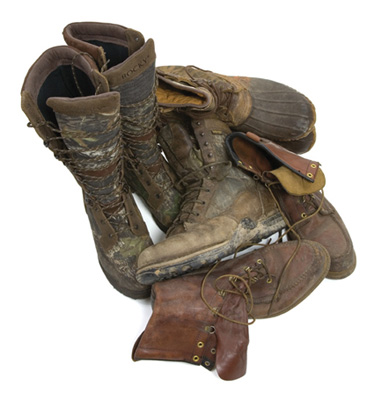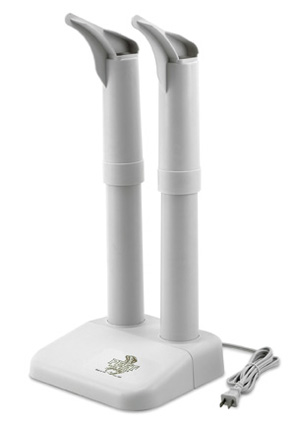 These days, few hunters would dream of carelessly tossing their guns into a corner of the basement after a day of hunting. We let our guns dry at room temperature. Then we clean them inside and out, apply copious amounts of lubricant, and store them in dehumidified vaults more plush than the abodes of most of the world’s people.
These days, few hunters would dream of carelessly tossing their guns into a corner of the basement after a day of hunting. We let our guns dry at room temperature. Then we clean them inside and out, apply copious amounts of lubricant, and store them in dehumidified vaults more plush than the abodes of most of the world’s people.
But first, we toss our boots down the stairwell.
Man, that is no way to take care of your boots. If you’re throwing your boots in the corner without care, you’re throwing away money and comfort. Take care of your boots, and they’ll take care of your feet for a very long time. I have an old pair of Golden Retriever boots that I’ve been hunting in since the year I got married — 14 years ago.
All hunting boots need at least a modicum of care. Even today’s high-tech synthetics such as Cordura should at least be air-dried, brushed clean with soft bristles and stored in a dry indoor space, out of direct sunlight. Beyond that, Cordura needs little attention.
Leather is a different matter. Leather is more like your skin. Actually, it is skin, usually from cattle, though hide from other animals are also used in hunting boots. Just as our skin needs regular cleansing and conditioning to remain youthful, so do leather boots. We all know leather can rot if left damp, but fewer people realize the damage caused by dirt or drying. Dirt particles cause abrasion of leather’s microscopic fibers if permitted to accumulate. Moreover, leather’s natural oils will become severely depleted if they’re not replenished by regular conditioning. The combination of abrasion and desiccation spells doom for leather boots.
Leather Lingo
 Different types of leather require different methods of cleaning and conditioning. The most common types of leather used in hunting boots are as follows:
Different types of leather require different methods of cleaning and conditioning. The most common types of leather used in hunting boots are as follows:
* Finished leathers (Top Grain and Full Grain): Hide does not come from an animal without surface imperfections or variations in thickness. Tanneries must process the hide to make it smooth and uniform. One key process is “splitting,” in which the hide is passed through a splitter to separate the inner and outer layers. The outer layer comes from the splitter in a sheet of uniform thickness. This outer layer may undergo a further process to remove skin blemishes, scars or other surface imperfections. In that case, it is called “top-grain” leather. But if the animal’s original skin surface is left unprocessed, the leather is called “full-grain” leather. Full-grain leather is more commonly used in hunting boots, and is usually “finished” with dyes or pigments and physical treatment, such as drumming or embossing, to produce color and texture. The finished product is the smooth brown leather we’ve all come to love in a classic pair of leather boots.
* Unfinished leathers (Suede and Nubuck): But what happens to the inner layer after splitting? The inner layer, sometimes called the “split,” is used to make suede. It’s buffed to produce a slightly fuzzy or velvety texture called a “nap,” and left unfinished. Nubuck feels like suede, but is produced from the outer layer of hide, not the split. Nubuck is simply top-grain leather that has been buffed to produce a suede-like nap, and then left unfinished. Nubuck is more commonly used in hunting boots, and is highly prized by many hunters for its quiet, soft, pliable feel and natural tan color.
Cleaning and Conditioning
 After hunting in dry conditions, don’t assume your boots are clean just because they don’t have any obvious mud caked on them. Wipe down finished leather boots with a soft, damp cloth. For Nubuck leather, you will probably find that a soft-bristled brush works better than a damp cloth. The brush seems to do a better job of picking dirt particles out of the nap. Just don’t brush the boots any harder than you would brush your own skin.
After hunting in dry conditions, don’t assume your boots are clean just because they don’t have any obvious mud caked on them. Wipe down finished leather boots with a soft, damp cloth. For Nubuck leather, you will probably find that a soft-bristled brush works better than a damp cloth. The brush seems to do a better job of picking dirt particles out of the nap. Just don’t brush the boots any harder than you would brush your own skin.
If your boots are plastered with mud, you have a bit more work to do. Cleaning, in this case, is the same for finished and unfinished leathers. Rinse them under running water to soften the mud while wiping it away with your hands or a soft brush. Rinse the boots totally clean. Don’t worry about ruining them with water. Saturation won’t do long-term damage to the leather as long as you dry the boots well and condition them. After rinsing, set the boots in a dry indoor location to dry completely.
It is okay to use a warm electric boot stand to dry your boots, but don’t use intense heat — such as a fire or camp stove — to dry them, as it might cause desiccation and cracking. While boots are drying, remove the insoles to make sure all parts of the boot dry completely. This will prevent the growth of bacteria that might further harm the boots from the inside.
When your boots are clean and dry, it’s time to condition them. Finished leathers should be treated with an oil or wax conditioner rubbed in with a soft, dry cloth. Many of these same conditioners will suffice also for nubuck, but they might flatten the nap that makes nubuck attractive in the first place. To preserve the nap of nubuck, fluff it up with a dry brush after the boots have dried, and then condition the boots with a spray-on conditioner made specifically for nubuck or suede. (See sidebar for product recommendations.)
If given proper care, leather boots will provide you with many years of weather-resistant comfort. And that means happy feet!
Some Great Boot Care Products
Conditioners for unfinished leathers:
Dansko’s Nubuck and Suede Protector Spray (www.dansko.com)
Ecco USA’s Oil Nubuck Waterproofing Spray (www.eccousa.com)
Conditioners for finished leathers
Montana Pitch Blend’s Leather Dressing (www.treatleather.com)
Mink Oil Crème by Bee Natural (www.bee-natural.com)
Note that I have not included any silicone conditioners in the above list. Some of today’s waterproof leathers are suitable for silicone conditioners, but others aren’t. And good luck finding out whether your boots are compatible with silicone from the scant information that comes in the boot box. I prefer to play it safe and use conditioners made from natural products such as pine pitch, beeswax and mink oil.
Drying can be hastened without damage to your boots with a good electric dryer. The gold standard of electric boot dryers is still the old faithful Peet Shoe Dryer, sold by numerous major retail stores. (www.peetshoedryer.com)






